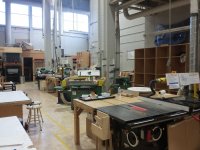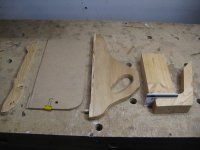- Joined
- Feb 22, 2016
- Messages
- 3,014
"His explanation was that the blade guard was inconvenient."
If only he could experience a week of 9-1/2 fingers then he might get a taste of what inconvenience is.
I have three 9 fingered friends who would like to tell him to use that guard.
As far as taking pride in being covered in dust at the end of the day. I never looked at it like that but I did have a job where I was covered in dust. It was more of a nuisance than a badge of honor. I was working on construction of a nuclear power plant as a pipefitter. Spent many a 10 hour day crawling around inside the reactor building running pipe, grinding J bevels for welds, installing pipe supports, etc. Looking back the place was filthy, even though they had people cleaning constantly. I would get two 4" air grinders and a stack of 12 or more grinding wheels at the beginning of the shift and most days they would all be gone by the end of the shift. You don't think that makes a mess try wearing out even one wheel and see what it's like. Now put over 100 people inside the same closed space with minimal ventilation and see how much swarf you take home with you. My clothes were covered with the grit and swarf from the steel plus the dust and debris from crawling around in the workspace. Towards the end of the job when the majority of the pipe and conduit and everything else was installed there were very few places where you could even stand up, that's how crammed it is inside there. My ears and nose would be filled with black grit and no doubt some of the bits of carbon or stainless steel I had been grinding on that day. In the 70s and 80s no one was handing out disposable ear plugs or dust masks to the thousands doing this type of work. On this one project alone we had over 1000 pipefitters welding and grinding. Add to that all the other trades and you can begin to envision the mess we worked in every day. When you blow your nose and nothing but black gunk comes out you have to think this can't be good.
If only he could experience a week of 9-1/2 fingers then he might get a taste of what inconvenience is.
I have three 9 fingered friends who would like to tell him to use that guard.
As far as taking pride in being covered in dust at the end of the day. I never looked at it like that but I did have a job where I was covered in dust. It was more of a nuisance than a badge of honor. I was working on construction of a nuclear power plant as a pipefitter. Spent many a 10 hour day crawling around inside the reactor building running pipe, grinding J bevels for welds, installing pipe supports, etc. Looking back the place was filthy, even though they had people cleaning constantly. I would get two 4" air grinders and a stack of 12 or more grinding wheels at the beginning of the shift and most days they would all be gone by the end of the shift. You don't think that makes a mess try wearing out even one wheel and see what it's like. Now put over 100 people inside the same closed space with minimal ventilation and see how much swarf you take home with you. My clothes were covered with the grit and swarf from the steel plus the dust and debris from crawling around in the workspace. Towards the end of the job when the majority of the pipe and conduit and everything else was installed there were very few places where you could even stand up, that's how crammed it is inside there. My ears and nose would be filled with black grit and no doubt some of the bits of carbon or stainless steel I had been grinding on that day. In the 70s and 80s no one was handing out disposable ear plugs or dust masks to the thousands doing this type of work. On this one project alone we had over 1000 pipefitters welding and grinding. Add to that all the other trades and you can begin to envision the mess we worked in every day. When you blow your nose and nothing but black gunk comes out you have to think this can't be good.


